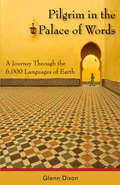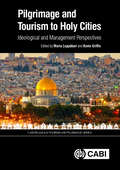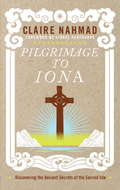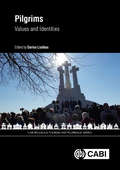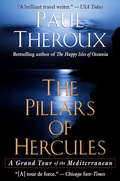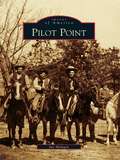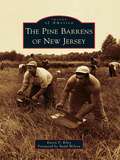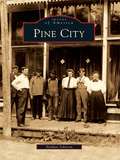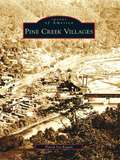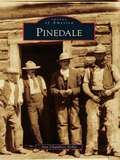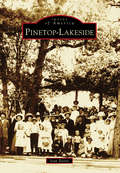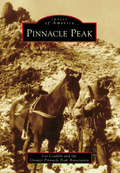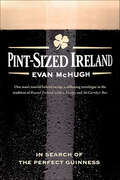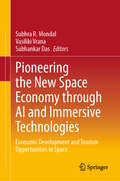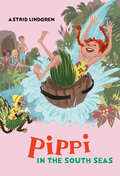- Table View
- List View
Pilgrim in the Palace of Words: A Journey Through the 6,000 Languages of Earth
by Glenn DixonPilgrim in the Palace of Words is about language, about the words that splash and chatter across our tongues. Some six thousand languages are still spoken on the planet, and author Glenn Dixon – an expert is socio-linguistics and a tireless adventurer – travels to the Earth’s four corners to explore the way these languages create and mould societies. As one philosopher said, languages are Houses of Being. After doing graduate work in linguistics, Dixon wanted to visit these houses or "palaces" himself – to stroll along their sidewalks, knock on their doors, and peek in their windows. He wanted to see what they were hiding in their basements … even if it meant a little bit of trouble. In some cases, a whole lot of trouble! Join him on his adventure as, with wit and humour, he works toward a real understanding of how and why we communicate the way we do in the Global Village.
Pilgrimage and Tourism to Holy Cities
by Kevin Griffin Maria LeppäkariThis book covers the ideological motives and religious perceptions behind travel to sites prescribed with sanctity in Judaism, Christianity and Islam. It covers sites that have drawn pilgrims and religious tourists to them for hundreds of years, and seeks to provide an understanding of the complex world of religiously motivated travel. Beginning with contemporary perspectives of pilgrimage across these religions, it then discusses management aspects such as logistics, infrastructure, malevolent behavior and evangelical volunteers. This book: - Provides a collection of new, contemporary perspectives on pilgrimage. - Reviews the ideological motives, history, mental health, and religious perceptions of tourism to holy cities. - Contains practical applications, models and illustrations of religious tourism and pilgrimage management from a variety of international and academic perspectives. Written by subject experts, this book addresses cultural sustainability for researchers and practitioners within religious tourism, religious studies, geography and anthropology.
Pilgrimage and Tourism to Holy Cities: Ideological and Management Perspectives (CABI Religious Tourism and Pilgrimage Series)
by Kevin Griffin Maria LeppäkariThis book covers the ideological motives and religious perceptions behind travel to sites prescribed with sanctity in Judaism, Christianity and Islam. It covers sites that have drawn pilgrims and religious tourists to them for hundreds of years, and seeks to provide an understanding of the complex world of religiously motivated travel. Beginning with contemporary perspectives of pilgrimage across these religions, it then discusses management aspects such as logistics, infrastructure, malevolent behaviour and evangelical volunteers. This book: - Provides a collection of new, contemporary perspectives on pilgrimage. - Reviews the ideological motives, history, mental health, and religious perceptions of tourism to holy cities. - Contains practical applications, models and illustrations of religious tourism and pilgrimage management from a variety of international and academic perspectives. Written by subject experts, this book addresses cultural sustainability for researchers and practitioners within religious tourism, religious studies, geography and anthropology.
Pilgrimage in Practice: Narration, Reclamation And Healing (Cabi Religious Tourism And Pilgrimage Series)
by Ian S. McIntosh Shirley Du Plooy Alison T. Smith E. Moore Quinn Vivienne Keely Matthew R. Anderson Mary Farrelly Tessa Garton George D. Greenia Richard LeSueur Suzanne Van Der BeekPilgrimage in Practice: Narration, Reclamation and Healing provides an interdisciplinary approach to the topic. It reveals many aspects of the practice of pilgrimage, from its nationalistic facets to its effect on economic development; from the impact of the internet to questions of globalization; from pilgrimage as protest to pilgrimage as creative expression in such media as film, art and literature. - Contests the very definitions of pilgrimage and challenges its paradigms. - Provides multiple perspectives on the subject to give a rounded and comprehensive review. - Covers past and present definitions of the sacred journey, the telling of stories, and historical injustices and their remedies through pilgrimage. Perhaps best understood as a form of heritage tourism or tourism with a conscience, pilgrimage (as with touristic travel) contains a measure of transformation that is often deep and enduring, making it a fascinating area of study. Reviewing social justice in the context of pilgrimage and featuring a diverse collection of interdisciplinary voices from across the globe, this book is a rich collection of papers for researchers of pilgrimage and religious and heritage tourism.
Pilgrimage in Practice: Narration, Reclamation and Healing (CABI Religious Tourism and Pilgrimage Series)
by Shirley Du Plooy Alison T. Smith E. Moore Quinn Vivienne Keely Matthew R. Anderson Mary Farrelly Tessa Garton George D. Greenia Richard LeSueur Dr Ian S. McIntosh Aateka Khan Suzanne Van BeekPilgrimage in Practice: Narration, Reclamation and Healing provides an interdisciplinary approach to the topic. It reveals many aspects of the practice of pilgrimage, from its nationalistic facets to its effect on economic development; from the impact of the internet to questions of globalization; from pilgrimage as protest to pilgrimage as creative expression in such media as film, art and literature. - Contests the very definitions of pilgrimage and challenges its paradigms. - Provides multiple perspectives on the subject to give a rounded and comprehensive review. - Covers past and present definitions of the sacred journey, the telling of stories, and historical injustices and their remedies through pilgrimage. Perhaps best understood as a form of heritage tourism or tourism with a conscience, pilgrimage (as with touristic travel) contains a measure of transformation that is often deep and enduring, making it a fascinating area of study. Reviewing social justice in the context of pilgrimage and featuring a diverse collection of interdisciplinary voices from across the globe, this book is a rich collection of papers for researchers of pilgrimage and religious and heritage tourism.
Pilgrimage in the Marketplace: Pilgrimage In The Marketplace (Routledge Studies in Pilgrimage, Religious Travel and Tourism)
by Ian ReaderThe study of pilgrimage often centres itself around miracles and spontaneous populist activities. While some of these activities and stories may play an important role in the emergence of potential pilgrimage sites and in helping create wider interest in them, this book demonstrates that the dynamics of the marketplace, including marketing and promotional activities by priests and secular interest groups, create the very consumerist markets through which pilgrimages become established and successful – and through which the ‘sacred’ as a category can be sustained. By drawing on examples from several contexts, including Japan, India, China, Vietnam, Europe, and the Muslim world, author Ian Reader evaluates how pilgrimages may be invented, shaped, and promoted by various interest groups. In so doing he draws attention to the competitive nature of the pilgrimage market, revealing that there are rivalries, borrowed ideas, and alliances with commercial and civil agencies to promote pilgrimages. The importance of consumerism is demonstrated, both in terms of consumer goods/souvenirs and pilgrimage site selection, rather than the usual depictions of consumerism as tawdry disjunctions on the ‘sacred.’ As such this book reorients studies of pilgrimage by highlighting not just the pilgrims who so often dominate the literature, but also the various other interest groups and agencies without whom pilgrimage as a phenomenon would not exist.
Pilgrimage to Dollywood: A Country Music Road Trip Through Tennessee
by Helen MoralesA star par excellence, Dolly Parton is one of country music’s most likable personalities. Even a hard-rocking punk or orchestral aesthete can’t help cracking a smile or singing along with songs like "Jolene” and "9 to 5. ” More than a mere singer or actress, Parton is a true cultural phenomenon, immediately recognizable and beloved for her talent, tinkling laugh, and steel magnolia spirit. She is also the only female star to have her own themed amusement park: Dollywood in Pigeon Forge, Tennessee. Every year thousands of fans flock to Dollywood to celebrate the icon, and Helen Morales is one of those fans. In Pilgrimage to Dollywood, Morales sets out to discover Parton’s Tennessee. Her travels begin at the top celebrity pilgrimage site of Elvis Presley’s Graceland, then take her to Loretta Lynn’s ranch in Hurricane Mills; the Country Music Hall of Fame and the Grand Ole Opry in Nashvil≤ to Sevierville, Gatlinburg, and the Great Smoky Mountains National Park; and finally to Pigeon Forge, home of the "Dolly Homecoming Parade,” featuring the star herself as grand marshall. Morales’s adventure allows her to compare the imaginary Tennessee of Parton’s lyrics with the real Tennessee where the singer grew up, looking at essential connections between country music, the land, and a way of life. It’s also a personal pilgrimage for Morales. Accompanied by her partner, Tony, and their nine-year-old daughter, Athena (who respectively prefer Mozart and Miley Cyrus), Morales, a recent transplant from England, seeks to understand America and American values through the celebrity sites and attractions of Tennessee. This celebration of Dolly and Americana is for anyone with an old country soul who relies on music to help understand the world, and it is guaranteed to make a Dolly Parton fan of anyone who has not yet fallen for her music or charisma.
Pilgrimage to Dollywood: A Country Music Road Trip through Tennessee (Culture Trails: Adventures In Travel Ser.)
by Helen MoralesA star par excellence, Dolly Parton is one of country music’s most likable personalities. Even a hard-rocking punk or orchestral aesthete can’t help cracking a smile or singing along with songs like “Jolene” and “9 to 5.” More than a mere singer or actress, Parton is a true cultural phenomenon, immediately recognizable and beloved for her talent, tinkling laugh, and steel magnolia spirit. She is also the only female star to have her own themed amusement park: Dollywood in Pigeon Forge, Tennessee. Every year thousands of fans flock to Dollywood to celebrate the icon, and Helen Morales is one of those fans. In Pilgrimage to Dollywood, Morales sets out to discover Parton’s Tennessee. Her travels begin at the top celebrity pilgrimage site of Elvis Presley’s Graceland, then take her to Loretta Lynn’s ranch in Hurricane Mills; the Country Music Hall of Fame and the Grand Ole Opry in Nashville; to Sevierville, Gatlinburg, and the Great Smoky Mountains National Park; and finally to Pigeon Forge, home of the “Dolly Homecoming Parade,” featuring the star herself as grand marshall. Morales’s adventure allows her to compare the imaginary Tennessee of Parton’s lyrics with the real Tennessee where the singer grew up, looking at essential connections between country music, the land, and a way of life. It’s also a personal pilgrimage for Morales. Accompanied by her partner, Tony, and their nine-year-old daughter, Athena (who respectively prefer Mozart and Miley Cyrus), Morales, a recent transplant from England, seeks to understand America and American values through the celebrity sites and attractions of Tennessee. This celebration of Dolly and Americana is for anyone with an old country soul who relies on music to help understand the world, and it is guaranteed to make a Dolly Parton fan of anyone who has not yet fallen for her music or charisma.
Pilgrimage to Iona
by Claire Nahmad Lionel FanthorpeA celebration of the beauty and mystery of Iona - a hallowed place of pilgrimage and spiritual self-discovery. With a history swathed in spirituality and mystery, the Scottish isle of Iona has always been revered as a holy place, the centre of Scottish Christianity. Legends abound of Jesus and Mary Magdalene alighting and living here before the Crucifixion, and Christ is believed to have visited the island with his mother. Celebrating sacred Iona as a place of pilgrimage, Claire Nahmad explores the fascinating ancient link between Iona and Rosslyn Chapel, the extraordinary unfinished building near Edinburgh, another prominent destination for those interested in biblical, masonic and pagan history. Nahmad takes you on a journey of revelation, unlocking the golden secret of the island and unveiling the undisclosed legacy of the Knights Templar.
Pilgrims: Values And Identities (CABI Religious Tourism and Pilgrimage Series)
by Rana P. Singh Josephine Pryce Dallen J Timothy Dr Daniel H Olsen Rubén C. Lois-González Pravin S. Rana Xosé M. Santos Dr Lucrezia Lopez Dane Munro Derek Dalton Rami Isaac Shin Yasuda Ali Thompson Kumi Kato María Ángeles Antelo Pedro Azevedo Luciana Thais Gonzalez Luis Alfonso Gómez Elyor E. Karimov Ricardo Nicolas Progano Xerardo Pereiro Kip Redick Larry Russell Augusta X. Thomson Slawoj TanasValues-rich journeys can be described as pilgrimage, spiritual travel, personal heritage tourism, holistic tourism, and valuistic journeys. There are many motivations for undertaking these journeys; the most important being personal values, life experience, personal and social identity, lifestyle, social and cultural influence. This book presents contributions that address pilgrim motivation, identity and values as they are shaped by the broader sociological, psychological, cultural and environmental perspectives. The focus of the book is the travellers themselves and their inner world through the lens of their pilgrimage. The research presented focuses on the typology of pilgrim journeys as ways in which identity and values are presented to a post-modern consumer society, providing interesting and challenging perspectives on the identity of pilgrims in the 21st century. The book: - Provides a framework for understanding the impact of values and identity on the motivation and behaviour of contemporary pilgrims. - Presents a comprehensive review of the latest research, a collection of case studies and models of practical applications. - Discusses the perceptions of tourism and pilgrimage in the age of value transformations and identity challenges.
Pillars of Hercules
by Paul TherouxIn this modern Grand Tour, Theroux sets off from Gibraltar on a journey around the Mediterranean Sea. It is a long, lively, and occasionally dangerous trip, up the coast of Spain, along the Riviera, by ferry to the islands of Corsica, Sardinia, Sicily, and beyond. By foot, train, bus, and cruise ship, Theroux travels around Italy and the Greek islands, to Albania in a state of near anarchy and to war-torn Croatia. He sails into Istanbul, its minarets and mosque domes beckoning him to the Levant. Ahead are Damascus and the villages of Syria, shrouded in the cult of Assad; Israel, besieged by suicide bombers; Egypt, Morocco and Paul Bowles' Tangier. Exploring wild coastlines, probing through layers of tradition and culture, ancient and modern, tawdry and splendid, Theroux weaves the legends and siren calls of civilizations as old as time into a story about life on the Mediterranean today
Pilot Point (Images of America)
by Jay MeluginThe oldest town in Denton County, Pilot Point is situated atop the highest point in North Texas at a place that was once a landmark for wagon train pilots traveling through the region. In 1854, the town was platted and lots were sold, many to cross-country pioneers who were drawn to the abundance of fresh water, game, and fertile soil. The city began to grow more quickly after incorporation in 1867, and when the railroad arrived in 1880, Pilot Point became one of the busiest trading centers in North Texas, boasting both the largest cotton gin and university. From the early days of cowboys and cotton in the 1800s, to oil and cattle in the 1930s, to the changes that came with the 1960s, this new volume tells the unique story of Pilot Point.
Pinch Me: Waking Up in a 300-Year-Old Italian Farmhouse
by Barbara BoyleFor fans of Stanley Tucci and Frances Mayes, Barbara Boyle’s story of leaving her California home to restore an old stone farmhouse in Italy’s Piedmont—only to fall in love with the food and people of her enchanting new town—will delight and inspire. An updated twist on the classic Under the Tuscan Sun, this is the deeply personal story of how fiftysomething Barbara Boyle leaves her busy and familiar life behind in San Francisco and begins taking apart a 300-year-old stone barn to build a new home—a new life—in the largely undiscovered region of Piedmont, Italy. Filled with discoveries and pleasures of the stunning places and food she encounters, Pinch Me also details Barbara’s frustrations in adjusting to a new culture, as well as the startling heartbreak of being faced with a breast cancer diagnosis. But even in the midst of this crisis, she and her husband create a home out of the stone ruin they had found, forming deep friendships in their little town and unlocking a new level of joy in life. She shares intimate moments, joyous and bittersweet, as a new wife, stepmom, and a member of a community—and, of course, she shares a few recipes reflecting the gastronomical excellence of the region. A touching memoir filled with food, friendships, and scenes of Italy, Pinch Me is ultimately a celebration of love, of learning to see the world, as well as oneself, through a different window, and of the powerful joy that comes from building a dream.
Pine Barrens of New Jersey, The
by Budd Wilson Karen F. RileyThe Pine Barrens of New Jersey cover 22 percent of the most densely populated state in the country. It is the largest stretch of open space between Boston, Massachusetts, and Richmond, Virginia. It reaches across 56 municipalities and 7 counties. The name came from early settlers who thought the area was a vast wasteland, but it is anything but barren. Underneath this incredible natural resource lies almost 17 trillion gallons of some of the purest water on earth. Stands of pitch pine gave birth to the charcoal industry, and its acidic swamps were used first for bog iron and later for cranberry production. Many firsts came from this area, including cranberry sauce, cultivated blueberries, and grape juice. Numerous industries have risen and fallen over time. Remnants of forgotten ghost towns bear witness to that history, but the real stories come from the people who lived and worked there.
Pine City
by Nathan JohnsonLaden with pines and interspersed with lakes and rivers, Pine City has long served as the gateway to Minnesota's Northwoods. Over the years, people have traveled through the area via the river, military road, railroads, and scenic highway. In the 1880s, as people of European decent were settling in, the crux of the community moved from Chengwatana, Ojibwe for "City of Pines," to a location west of there, nearer the rail line, called Pine City. The story begins with the fur trade and takes one through a fascinating journey of the logging industry, showing the rural community's transition from predominantly agricultural underpinnings to a more diversified economy. This collection of vintage photographs highlights Pine City's laboring people and other influences that have had roles in shaping what it is today-a city of great history, unique people, nostalgic small-town traditions, and mystifying legends.
Pine Creek Villages (Images of America)
by David Ira KaganPioneer settlers began arriving in Pine Creek Valley after the Revolutionary War, drawn to the pristine wilderness filled with towering white pines and hemlocks. In the 1880s, descendants of those settlers began extensive lumbering operations aided greatly by the arrival of the railroad through the valley. Additional logging railroads were rapidly constructed up the tributary runs to the great stands of trees. Pine Creek's villages flourished, with both large and small sawmills buzzing. Around 1910, when the great lumbering days ended, many of the village populations plummeted. Throughout the 20th century and into today, the area remains a popular tourist destination for fishing, hunting, and outdoor enthusiasts.
Pinedale
by Ann Chambers NobleJohn F. Patterson founded Pinedale in 1904 after proposing the establishment of a town along Pine Creek in western Wyoming. Patterson offered to build and stock a general store if local ranchers Charles Petersen and Robert Graham would donate five acres each for the site. Petersen and Graham agreed to this plan, a surveyor was hired, and Pinedale--named after the post office on Petersen's ranch--was officially established. Free town lots were offered to early settlers, and Pinedale was incorporated in 1912, becoming the farthest incorporated town from a railroad, and later from a major highway, in the country. The community survived in fierce isolation, and the townspeople originally made their living supplying the ranchers, outfitters, and tie hacks. Ranching and tourism helped sustain Pinedale from the beginning, and in the 1990s, the community underwent a fundamental change with the introduction of natural-gas mining in the area. Pinedale residents continue to live and thrive on this harsh but beautiful land.
Pinetop-Lakeside
by Joan BaezaIn 1984, the White Mountain communities of Pinetop and Lakeside in east-central Arizona undertook a "marriage of convenience" and incorporated. Historically, they could not be more different. Like rival sisters, one was pious and churchgoing while the other was wayward and fun loving. But in the best of American traditions, they formed a town government to provide services for their combined residents. Pinetop-Lakeside's history is as rough-and-tumble as that of any Western town. Settlement began with the establishment of Fort Apache in 1871. The cavalry post provided employment for freighters and skilled laborers, as well as a market for beef, hay, and grain. The 1880s brought colonists from the Church of Jesus Christ of Latter-day Saints. They built the dams and lakes that in the next century would become the basis for an economy based on outdoor recreational tourism. Today, Pinetop-Lakeside is a thriving community of approximately 4,500 residents. One thing that hasn't changed since the time of the pioneers is the natural beauty that defines life on the mountain.
Pink Tourism: Holidays of Gay Men and Lesbians
by Howard L. HughesThis book presents a detailed picture of gay and lesbian tourism from, primarily, a marketing perspective and examines how marketing activity engages with and affects social issues relating to homosexuality. It gives an overview of the nature of homosexuality and relevant issues that bear upon tourism and marketing.
Pinkalicious: Lost In Paris (I Can Read Level 1)
by Victoria KannYoung readers will be swept up in Pinkalicious’s pinkatastic Parisian adventure in this Level One I Can Read!Pinkalicious gets distracted and loses track of Mommy, Daddy, and Peter on a family trip to Paris. But fortunately, Pinkalicious remembers Mommy's advice and knows what to do!Pinkalicious: Lost in Paris is a Level One I Can Read, which means it’s perfect for children learning to sound out words and sentences. Whether shared at home or in a classroom, the short sentences, familiar words, and simple concepts of Level One books support success for children eager to start reading on their own.Readers can watch Pinkalicious and Peter on the funtastic PBS Kids TV series Pinkalicious & Peterrific!
Pinnacle Peak
by Greater Pinnacle Peak Association Les ConklinPinnacle Peak is north Scottsdale's most prominent landmark, rising out of the desert floor to an elevation of 3,170 feet. For years, Pinnacle Peak was Scottsdale's "secret" destination for hiking, rock climbing, and horseback riding. In 1985, with urban sprawl surging northward, Scottsdale's city council acted to preserve Pinnacle Peak as a municipal park. Pinnacle Peak visitors are impressed by the sweeping vistas, the rugged beauty of the Sonoran Desert, the manicured golf courses, and the unique wildlife. Few people realize that the surrounding landscape covers the forgotten footprints of prehistoric hunter-gatherers, Hohokam, Yavapai, the US Cavalry miners, homesteaders, ranchers, developers, and colorful characters of the past. Spanning 150 acres, Pinnacle Peak Park has become one of the most popular attractions in the Phoenix metropolitan area, and its scenic beauty is enjoyed by people from all over the world.
Pint-Sized Ireland: In Search of the Perfect Guinness
by Evan McHughOne man's tour of Ireland on tap; a rollicking travelogue in the tradition of Round Ireland with a Fridge and McCarthy's Bar."Regret" is the word that best describes Evan McHugh's first taste of Guinness. For an Australian raised on Vegemite, Ireland's black brew is very much an acquired taste. But the travel-writer is committed to acquiring it. Determined to discover exactly what makes a pint of Guinness so legendary, he crosses the Emerald Isle in search of his answers.But in sampling pints as he goes, McHugh soon realizes that in each town, and at every pub, someone always says that the best glass of Guinness is to be found . . . . somewhere else. In his comedic and sentimental journey, McHugh and his companion, Twidkiwodm (the-woman-he-didn't-know-he-would-one-day-marry), hitch around Ireland, meeting unforgettable characters. He goes rowing with a German bagpiper on the lakes of Killarney, windsurfing with a one-armed man in Dingle, survives an encounter with poteen and even finds his own bar . . . but keeps searching for the perfect pint.As entertaining as it is informative, Pint-Sized Ireland is both a hilarious travelogue and thoughtful diary. McHugh's comedic voice swiftly moves in and out of pubs, peering into froth-rimmed pints, and leading readers to question: So does he ever find the perfect pot of black gold? Those who have rested upon the barstools of Ireland, who have sought the famed "perfect pint of Guinness," realize that perfection rests in more than just the taste. McHugh captures the visceral experience of Guinness and Ireland in a warm memoir that's perfect to savor.International Praise for Pint-Sized Ireland"McHugh's idea of traveling is one continuous pub crawl . . . an entertaining homage to the black brew."---The Age (Australia)"McHugh's writing style is intelligent, quirky, and conversational. The result is a consummately easy to read book, amusing and engaging. It'll make you want to go in search of your own perfect pint."---Adventure Travel"This is a lovely book, well written, full of humorous anecdotes and works both as a travelogue and as a guide to drinking in Ireland. One of the real joys of this book is the way that the author captures the nuances and syntax of the way the people speak (‘"Rooit", said the pub-landlord, ‘in ye coom"'). After a few pages you find yourself falling into this yourself and by the time you finish the book you will have developed a full-blown Irish accent."---www.bootsnall.com
Pioneering the New Space Economy through AI and Immersive Technologies: Economic Development and Tourism Opportunities in Space
by Subhankar Das Subhra R. Mondal Vasiliki VranaThis book provides a comprehensive, forward-looking examination of how artificial intelligence, immersive technologies, and anthropomorphized robots shape the future of space exploration and commercialization. Space tourism is on the brink of a revolutionary transformation driven by technological advancements and a growing private sector involvement. Bringing together experts from diverse fields, including aerospace engineering, computer science, economics, law, and psychology, the book offers a comprehensive, multidisciplinary perspective on the challenges and opportunities in this exciting new frontier. An essential resource for academics, industry professionals, policymakers, and enthusiasts interested in the intersection of space exploration, tourism, and advanced technologies, the book aims to inspire and inform the next generation of space entrepreneurs, researchers, and explorers by providing a comprehensive overview of current developments and future possibilities in space economy.
Pippi in the South Seas (Pippi Longstocking)
by Astrid LindgrenWhen Pippi&’s father, the king, sends for her, she decides to take her best friends Tommy and Annika with her to Kurrekurredutt Island. The island is fantastic and Pippi has one crazy adventure after another! Pippi is even made a princess---Princess Pippilotta. But will Pippi and her friends really want to live on the island forever, never to return to Villa Villekulla? "Any reappearance of the irrepressible Pippi Longstocking is cause for celebration. This installment is no exception." -The New York Times
Piracy, Turtles and Flying Foxes (Great Journeys Ser.)
by William DampierDampier's (1651-1715) adventures and writing inspired both Robinson Crusoe and Gulliver's Travels, but in his own right he was a remarkable, observant and enjoyable writer - whether on a woefully mishandled pirate raid in Spanish America or on a desperate journey to Sumatra in an open boat or on the habits of manatees or bats. He also left the first description in English of the Aborigines of Australia - thus initiating a painful, now three centuries' long encounter between peoples on opposite sides of the world.Great Journeys allows readers to travel both around the planet and back through the centuries – but also back into ideas and worlds frightening, ruthless and cruel in different ways from our own. Few reading experiences can begin to match that of engaging with writers who saw astounding things: Great civilisations, walls of ice, violent and implacable jungles, deserts and mountains, multitudes of birds and flowers new to science. Reading these books is to see the world afresh, to rediscover a time when many cultures were quite strange to each other, where legends and stories were treated as facts and in which so much was still to be discovered.
